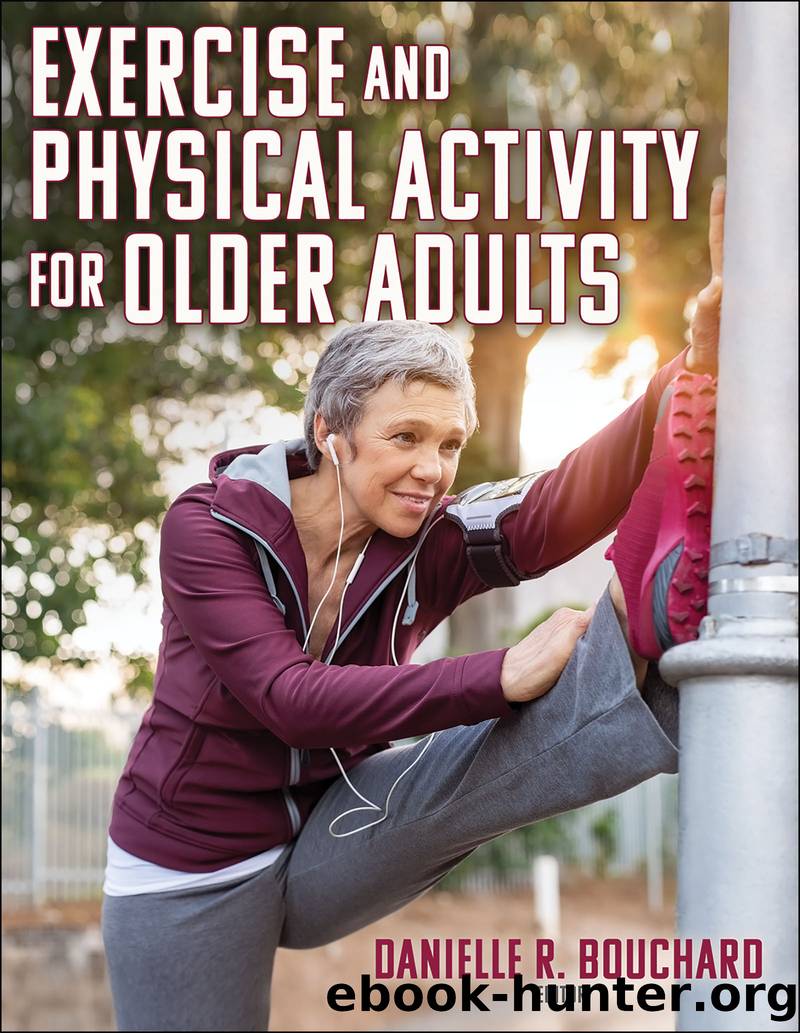Exercise and Physical Activity for Older Adults by Unknown

Author:Unknown
Language: eng
Format: epub
Publisher: Human Kinetics, Inc.
MEDICATION CONSIDERATIONS
Older adults are more likely to be taking one or more medications that may affect exercise performance, safety, and physical activity levels, with approximately 30% of older adults age 65 and older taking five or more medications (Matsuo, So, Sasai, & Ohkawara, 2017; Scholes et al., 2014; Woods, Weinborn, Velnoweth, Rooney, & Bucks, 2012). These effects may be more pronounced in older adults given the way that the aging process changes pharmacodynamics and pharmacokinetics (i.e., the ways that medications are absorbed, excreted, and metabolized). Reductions in lean body mass, total body water content, transit time of the gastrointestinal system, and efficiency of the liver and kidneys all contribute to the increased likelihood of side effects and the potential for toxicity (Matsuo et al., 2017). In addition, some medications may affect exercise responses and alter exercise prescription (Fletcher et al., 2013; Scholes et al., 2014). For example, beta-blockers are a common heart medication given for angina in older adults with CVD, and their primary mechanism of action is to block beta receptors, which are responsive to sympathetic nervous system stimulation. These effects may prevent the predictable rise in heart rate (HR) and blood pressure (BP) expected during an exercise test, which may confound interpretation. Nevertheless, it is routine to continue beta-blockers, and most other cardiovascular medications, during an exercise test, as this is vital for safety (Fletcher et al., 2013). Thus, exercise testing results and exercise prescription usually rely relatively more on ratings of perceived exertion (RPE) or gas exchange assessments rather than HR as an index of exercise intensity.
Download
This site does not store any files on its server. We only index and link to content provided by other sites. Please contact the content providers to delete copyright contents if any and email us, we'll remove relevant links or contents immediately.
Application of a Novel Technique for Clinical Evaluation of Nitric Oxide-Induced Free Radical Reactions in ICU Patients by Unknown(715)
Rosenâs Emergency Medicine Concepts and Clinical Practice by Ron Walls; Robert Hockberger; Marianne Gausche-Hill; Timothy B. Erickson; Susan R. Wilcox(588)
Oxidative damage to surfactant protein D in pulmonary diseases by Vitality Starosta1 & Matthias Griese1†(431)
Social Science Perspectives on Global Public Health by Vincent La Placa & Julia Morgan(393)
Genetic engineering of grain and pasture legumes for improved nutritive value by Unknown(379)
Constructing Canine Consent; Conceptualising and Adopting a Consent-focused Relationship with Dogs by ERIN JONES(349)
Organic Chemistry: An Acid - Base Approach by MICHAEL SMITH(320)
ADVANCED EMERGENCY CARE AND TRANSPORTATION OF THE SICK AND INJURED by Unknown(296)
Saunders Nursing Drug Handbook 2024 - E-Book by Unknown(285)
Diagnostic and Statistical Manual of Mental Disorders, Fifth Edition, Text Revision (DSM-5-TR(tm)) by Unknown(284)
Access to Medicines and Vaccines in the South : Coherence of Rules and Policies Applied by the European Union Commission by Stephen Kingah(280)
Davis's Comprehensive Manual of Laboratory and Diagnostic Tests with Nursing Implications by Unknown(267)
Human Microanatomy; Cell Tissue and Organ Histology with Celebrity Medical Histories by Stephen A. Stricker(264)
Socio-Life Science and the COVID-19 Outbreak : Public Health and Public Policy by Makoto Yano; Fumihiko Matsuda; Anavaj Sakuntabhai; Shigeru Hirota(264)
Berne and Levy Physiology E-Book by Unknown(251)
Replacing the Dead by Mie Nakachi;(249)
Handbook of Skin Disease Management by Jiyad Zainab;Flohr Carsten; & Carsten Flohr(247)
The Pocket Guide to Sensorimotor Psychotherapy in Context (Norton Series on Interpersonal Neurobiology) by Pat Ogden(242)
Deep Learning and Medical Applications by Unknown(238)
